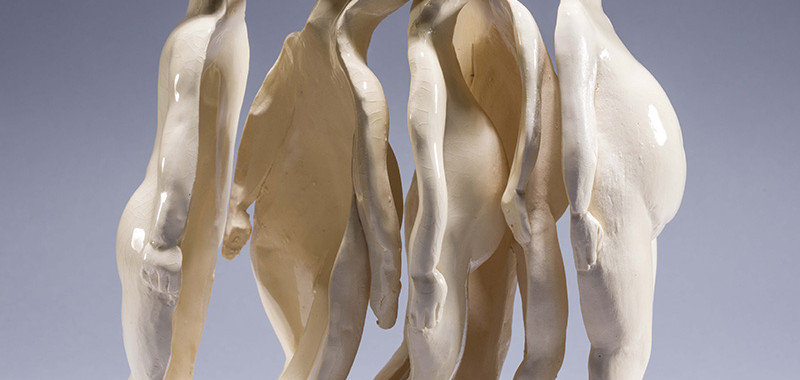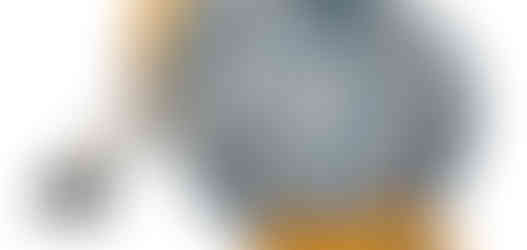
MOA curator Carol Mayer with Brendan Lee Satish Tang and Judy Chartrand, who were give RACISM as a starting point for their artist conversation (photo by Gillian McMillan).
Playing with Fire: Ceramics of the Extraordinary
11 Internationally Renowned BC-Based Artists Explore Boundaries of Ceramic Art,
Inviting Viewers to Consider the Discursive Possibilities of the Medium
The following is a news release from the MOA about this important BC clay exhibition:
The Museum of Anthropology (MOA) at UBC presents the thought-provoking exhibition, Playing with Fire: Ceramics of the Extraordinary, on display from November 22, 2019 to March 29, 2020. Showcasing a group of 11 highly celebrated BC-based artists, this premiere exhibition of ceramic works expresses strong opinions on urgent social issues and offers subtle perspectives on the state of our contemporary world. While at first glance these works may appear very approachable through a lens of nostalgia, beauty, or humour, upon closer inspection they reveal much deeper commentaries on social injustice, racism, identity, and censorship. This powerful exhibition invites visitors to explore the many layers of understanding each of these provocative works embody, boldly demonstrating clay’s myriad discursive possibilities.
“I have always been interested in introducing some alternative to the presumption that BC ceramics are only about brown pots, living on islands, and rejecting commercialism,” explains Carol E. Mayer, MOA’s Curator of the Pacific and Ceramics. “When clay is released from its functional imperative and rethought as a medium of sculptural expression it can be taken in multiple directions — doors open to the possibility of creating works that address and comment on compelling aspects of the human condition and contemporary reality.”
Playing with Fire features the work of 11 internationally recognized BC-based artists — Judy Chartrand, Ying-Yueh Chuang, Gathie Falk, Jeremy Hatch, Ian Johnston, David Lambert, Glenn Lewis, Alywn O’Brien, Bill Rennie, Debra Sloan, and Brendan Tang — who are all acclaimed for their fearless innovation in ceramic work. Working in clay, the most accessible of mediums, and drawing inspiration from pop culture, art history, humour, beauty, hope, and nature, these artists bring fresh, playful, and challenging perspectives of the art form. Visitors will be encouraged to discover new meanings and uncover complexities hidden, often in plain sight, within the works.
For this exhibition, more than 35 ceramic installations will be on display — some of which are epic in scale, including Johnston’s The Antechamber (2010–2012), in which a 25-foot-long room is covered with a repeating, grid-like motif of ceramic elements, created through a vacuum-forming process. The result of these overlapping elements, hanging like roof tiles, evokes the massive scale of consumption of manufactured goods today.
The exhibition gallery will be transformed into a container of possibilities in which the sculptures both occupy and comment on the spaces they inhabit. O’Brien’s earthenware and porcelain sculptures push the medium as a vehicle to explore the question, “What is the vessel?” Known for her extensive knowledge of the history of decorative arts and passion for baroque, O’Brien dissects the definition of the vessel through her lacey hand-rolled coils used in a deliberate yet chaotic way to construct volume and shape.
Rennie’s work also addresses space as he creatively evokes a sense of place as embodied in fabled architecture and specific locales. By working with clay slabs and press moulds, he constructed a large-scale and highly detailed model of his childhood home in Surrey entitled Where I Was Brought Up. Visitors will have the opportunity to view this thoughtful piece mediated by Rennie’s cultural history that is both a represented and presented space.
Another powerful piece in the exhibition is Chartrand’s 2006 installation entitled Counteract. Upon first glance, Chartrand has recreated a diner’s bar with stools, but closer inspection addresses important Indigenous issues and reveals biting commentary on racism and segregation, particularly in the context of Vancouver’s Downtown Eastside.
In pushing the exploration of space, Playing with Fire extends beyond the confines of the exhibition gallery and into other areas of the museum. Two artists — David Lambert and Debra Sloan — will be presented in MOA’s Multiversity Galleries and Koerner European Ceramics Gallery respectively, where their works will be in dialogue with the objects on permanent display, adding new contextual layers for interpretation.
Lambert, sometimes referred to as the godfather of BC Ceramics, reached a commercial heyday in the 1950s selling pottery with “Indigenous” designs to offer a more comprehensive representation of Canadian art in the marketplace. Now to be displayed among MOA’s collection of objects from Pacific Northwest Coast First Nations in the Multiversity Galleries, Lambert’s work takes on a renewed relevance in today’s conversations of cultural appropriation.
As part of her year-long artist residency at MOA, Sloan studied and created works in response to the Koerner European Ceramics, in particular the collection of Haban ware from 17th and 18th centuries, made by the Anabaptists, who fled Florence due to religious persecution. Drawing from this inspiration, her works highlight the ongoing yet ever urgent subject of worldwide migration.
Playing with Fire will incorporate many layers of technical prowess and symbolic power, superbly demonstrating clay’s infinite artistic possibilities. In Tang’s Magna Ormulu series, he reconfigures historical art traditions through the use of clay and mixed media. Intrigued by cultural appropriation and hybridity, Tang incorporates these predominant themes in his work to reflect his own ambiguous cultural identity. Although he is labeled by others as Asian-Canadian, Tang considers his family disconnected from Asia through several generations of migrational displacement and interracial marriage. Thus, he employs self-portraiture in his work to address issues of race, ethnicity, class, and culture.
Taiwan-born Chuang also addresses cultural identity and class through her art. Chuang is selective about how she adapts Western philosophies and ways of living in her art and prefers to convey a hybrid existence, adopting elements from both Western and Taiwanese cultures — Chuang’s interest in hybridization has led her to incorporate elements from plants or sea anemones in her stunning clay works, combining and creating forms that are symmetrical and asymmetrical.
The 11 artists featured in Playing with Fire boldly challenge long-held notions of the functionality of clay — they have released this unassuming yet utterly transformable material from this constraint to create extraordinary works of art. Visitors will be awe-inspired by the power of each work and compelled to reconsider their own perceptions of clay as an art form.
About MOA (moa.ubc.ca) The Museum of Anthropology (MOA) at the University of British Columbia (UBC) is world-renowned for its collections, research, teaching, public programs and community connections. Founded in 1949 in the basement of the Main Library at UBC, its mission is to inspire an understanding of and respect for world arts and cultures. Today, Canada's largest teaching museum is located in a spectacular Arthur Erickson-designed building overlooking mountains and sea. MOA’s worldwide collections consist of more than 42,000 cultural objects and artworks created in Asia, Africa, Oceania, Europe and the Americas — with a focus on the Pacific Northwest. MOA's Multiversity Galleries provide public access to more than 9,000 of these objects and artworks. The Audain Gallery and the O’Brian Gallery, MOA’s temporary exhibition spaces, showcase travelling exhibitions, as well as those developed in-house.
EXHIBITION DATES: November 22, 2019 to March 29, 2020
LOCATION: Museum of Anthropology, University of British Columbia, 6393 NW Marine Drive, Vancouver, BC
WEBSITE: moa.ubc.ca














Comments